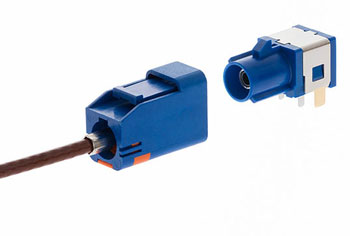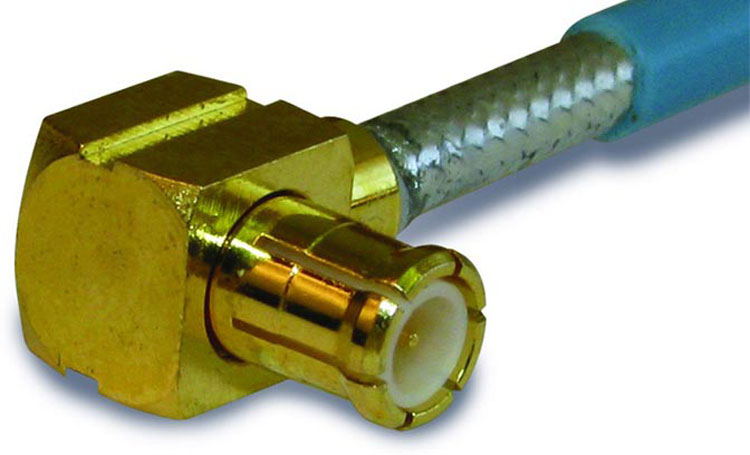Making a connection: a summary of RF connector trends
In a cost-effective way, Radio Frequency (RF) connectors seek to transfer data across multi-megahertz radio frequencies with minimal data loss from reflection and dispersion. Situated at the end of every cable with the job of transferring data to the next PCB or system, RF connectors operate like a gateway to the device-under-design; select the right one and the data being transferred passes without the least delay, select the wrong one and the signal will be slowed down or even held-up by reflections, leakage and attenuation.
Dividing into circular and rectangular formats, factors that influence the choice of geometry of RF connector include ease of engagement and disengagement, mechanical performance and environmental sealing.
Whichever you pick, they form part of a pair: one mounted on the PCB, the other on the cable. The former is generally female and the latter male, though as with most things, there are exceptions, such as genderless/hermaphroditic variants.
When choosing a connector for any application, your primary design considerations will include selecting acceptable levels of resistance, with 50 or 75ohm representing characteristic impedances; reflection, with 1.0 VSWR representing no reflection; and RF leakage tolerance, with a totally shielded connector achieving none whatsoever. Affecting these primary performance characteristics is a gamut of additional electrical, mechanical, environmental, material and economic considerations. Governing your overall choice will be the necessity to match the characteristic impedance of the cable, even while maintaining this impedance becomes more complex as the frequency increases.
Connector manufacturers continue to improve reliability and device quality, by turning to new materials and manufacturing techniques. Recent years have seen the emergence of specialised connectors, such as those able to withstand extreme temperatures. With hundreds of RF connectors to choose from, here’s a list of the main trends in RF connection as we see them:
Miniaturisation The dominance of all things handheld/mobile combined with requirements to minimise the footprints of M2M and Internet of Things (IoT) applications are driving requirements for smaller, lower-profile components capable of higher speeds. In the case of RF connectors, the increase in complexity and integration of devices is matched by the components they comprise. The trend towards sub-miniature and micro-miniature connectors can be seen in whatever type of RF connector you choose to look at, whether it is MMCX taking over from MCX, or SMPM and SMPS taking over from SMP, and lest we forget, the UMCC (take a look at Hirose’s U.FL range for a truly tiny connection!).When small size and high performance are important, Samtec’s RF047 flexible microwave cable assembly is ideal for high speed, high cycle test applications where the size of a U.FL connector is required but a more rugged and reliable interface is needed and offers 500 cycles and 10 GHz performance with a U.FL cable plug.
The dominance of all things handheld/mobile combined with requirements to minimise the footprints of M2M and Internet of Things (IoT) applications are driving requirements for smaller, lower-profile components capable of higher speeds. In the case of RF connectors, the increase in complexity and integration of devices is matched by the components they comprise. The trend towards sub-miniature and micro-miniature connectors can be seen in whatever type of RF connector you choose to look at, whether it is MMCX taking over from MCX, or SMPM and SMPS taking over from SMP, and lest we forget, the UMCC (take a look at Hirose’s U.FL range for a truly tiny connection!).When small size and high performance are important, Samtec’s RF047 flexible microwave cable assembly is ideal for high speed, high cycle test applications where the size of a U.FL connector is required but a more rugged and reliable interface is needed and offers 500 cycles and 10 GHz performance with a U.FL cable plug.
Higher frequency and high power
The exponential increase in data is causing escalating demand for microwave-capable RF connectors as backhaul systems move to fibre and microwave. Traditionally, microwave systems required only sub-6 GHz performance, but systems now operate in the 26/28 GHz range and beyond. The trend towards 60 GHz in telecommunications and radio technology is yet another factor driving requirements for smaller components and higher packing densities, as the smaller the mechanical dimensions, the higher the frequencies catered to.
Examples within our line card include Amphenol’s SMA RF connectors, which have a VSWR performance up to 26.5 GHz and cater to multiple PCB thicknesses. Molex also caters to high-frequency applications, with its RF solutions range serving DC to 65 GHz and Hirose offers high-speed coaxial connectors supporting up to 50 GHz that meet the MIL-STD348B standard. These connectors are heavily shielded against EMI and RFI and can withstand thousands of plug-and-unplug operations without failure.
Notably, two of our suppliers, Molex and TE Connectivity, are collaborating on new connector and cable assembly products for high-speed applications i.e. 56 GHz and beyond. When choosing connectors for high frequency applications, don’t forget that the accepted limits are generally 90% of their theoretical cut-off frequency.
Quick connect/disconnect
Increased demand for quick-connect locks (push-pull, bayonet, snap locks) that withstand cable strain and vibration shows no sign of abating, especially as mobile phones and other applications need micro connectors that are user-friendly. Examples include the QMA and QN connectors, which have been available for some years and were designed to replace SMA and Type N – Avnet Abacus sells versions from Amphenol, Molex and TE. For frequent connect and disconnect applications, it is important to choose a connector designed for the right number of mating cycles. For example, Amphenol’s MCX coaxial connector range guarantees 500 mating cycles minimum. We can provide advice on the mating forces required for relevant products and minimum/maximum mating cycles.

Alternate finishes/materials
Characteristics that influence the choice of materials used for RF connectors include contact force and surface smoothness, electrical and thermal conductivity, machinability, and environmental conditions, like temperature range. Brass and stainless steel remain the materials of choice for RF connector housings, but since 2008, bronze copper beryllium has replaced copper beryllium for the spring contacts. White Bronze (a copper, tin and zinc alloy) plating for RF connectors has been a popular choice over nickel or silver for some time, thanks to its improved electrical and intermodulation performance, better wear characteristics and low insertion loss.
Driving more recent developments are mission-critical applications such as automotive, military and medical. For example, connectors for the medical market (e.g. scopes and probes) must be non-magnetic, so here a traditional nickel-plating for the contacts is replaced with electro less nickel phosphorous. As an example, Molex offers non-magnetic solutions with virtually any RF connector and cable to minimise distortion in medical and aerospace imaging applications while meeting high-frequency and -density requirements
Another avenue of interest for RF connectors is plastic. In recent decades, various electrically conductive plastic products have been developed. With low density and good electrical and dielectric properties, connectors using electrically conductive plastic are of growing interest and, as a result, plastic is becoming a regular feature of the materials mix. An illustration of this can be seen in FAKRA type RF connectors. With colour coded plastic housings that simplify identification, plus unique keying to prevent mis-mating, they perform up to 3 GHz and meet the mechanical and environmental needs of the automotive industry.
For more from Avnet Abacus click here.







